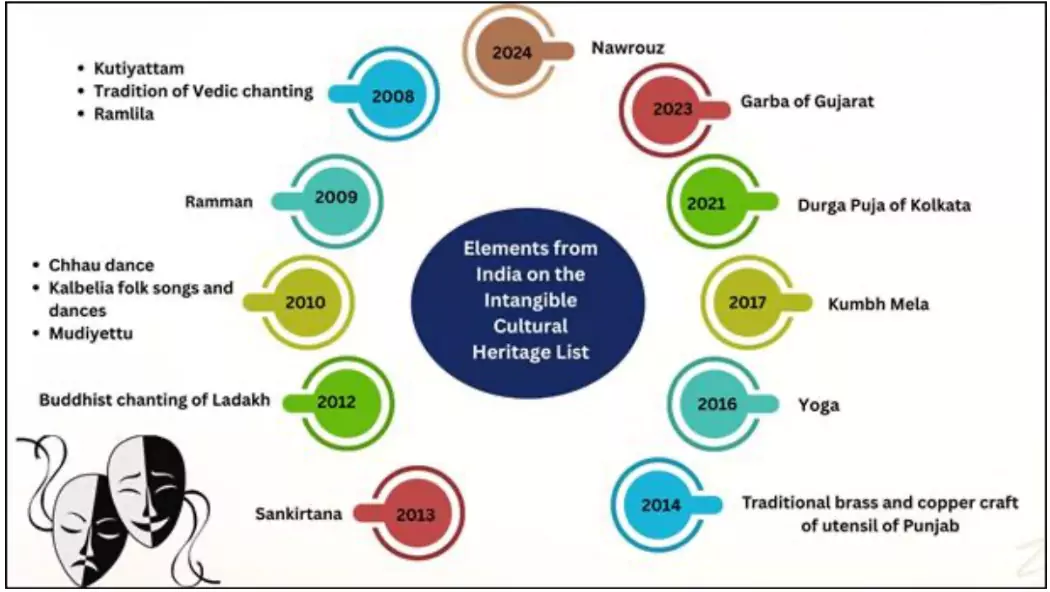Ritual theatres of India blend sacred rituals with dramatic performance, embodying religious storytelling, community participation, and transmission of cultural values.
- UNESCO has recognised several such traditions as Intangible Cultural Heritage (ICH), underscoring their global significance and the need for safeguarding.
About Intangible Cultural Heritage (ICH)
- Definition: Intangible Cultural Heritage refers to living traditions, practices, expressions, knowledge, and skills that communities recognize as part of their cultural heritage.
- Defined under the UNESCO Convention for the Safeguarding of the ICH, 2003.
- Domains (5): Oral traditions, Performing Arts, Rituals & Festive Events, Knowledge of Nature & Universe, Traditional Craftsmanship.
- India’s ICH elements: 15 inscribed so far, including Kutiyattam, Mudiyettu, Ramman, and Ramlila.
- Chhath puja from Bihar has been nominated in september 2025.

About Kutiyattam (Kerala)
- Nature: Sanskrit theatre tradition, over 2,000 years old.
- Features:
-
- Codified expressions (neta abhinaya, hasta abhinaya), elaborate enactments lasting up to 40 days.
- Performed in kuttampalams (temple theatres) with ritual sanctity.
- Transmission: 10–15 years of training under guru-shishya parampara.
- Fusion: Blends Sanskrit drama, acting, abhinaya, and music.
- Themes: Divine storytelling, sacred stage, community-supported art.
Mudiyettu (Kerala)
- Nature: Ritual dance-drama depicting Kali’s battle with Darika, performed annually after harvest.
- Features:
-
- Held in Bhagavati Kavus (temple precincts).
- Begins with kalamezhuthu (ritual drawing of goddess image).
- The entire village, across castes, contributes (mask making, costumes, ritual roles).
- Fusion: Dance, music, masks, drama, visual art.
- Apprenticeship ensures continuity.
Ramman (Uttarakhand)
- Nature: Annual festival of Saloor-Dungra villages in honour of Bhumiyal Devta.
- Features:
-
- Combines rituals, epic recitations, masked dances, and oral traditions.
- Instruments: Dhol, Damau, Manjira, Jhanjhar, Bhankora.
- Caste-based roles (priests, mask-makers, drummers) with entire village participation.
- Oral transmission sustains continuity.
- Fusion: Theatre, music, dance, masks, storytelling.
Ramlila (North India)
- Nature: Dramatic re-enactment of Ramayana, especially during Dussehra.
- Features:
-
- Based on Tulsidas’ Ramcharitmanas.
- Performed in temple grounds or public spaces.
- Community-driven: amateur actors, local funding, large-scale public participation.
- Varies in duration: 10–12 days, up to a month (Ramnagar, Varanasi).
- Fusion: Narrative drama, music, choreography, dialogue, costumes.
Institutional Role: Sangeet Natak Akademi
- Mandate: Apex body (est. 1953) for preservation and promotion of performing arts.
- Functions:
-
- Documentation & Archiving – audio-visual records, manuscripts, publications.
- Training – supports guru-shishya parampara, workshops, camps.
- Recognition – awards (Akademi Awards, Fellowships, Ustad Bismillah Khan Yuva Puraskar).
- Research & Publications – books, journals, monographs.
- Festivals & Performances – national theatre and dance festivals.
- Collaboration with UNESCO – nominations and safeguarding of ritual theatres.
- Artiste Support – stipends, grants, infrastructure.
Significance of Ritual Theatres
- Divine Storytelling: Narratives drawn from epics, legends, and deities.
- Sacred Spaces: Performed in temples, courtyards, or ritual spaces.
- Community Participation: Collective ownership, caste/community roles.
- Transmission: Oral, performative, and apprenticeship-based knowledge transfer.
- Fusion of Arts: Blends theatre, dance, music, oral literature, and craft.
![]() 30 Sep 2025
30 Sep 2025


